2007 CHEVROLET MALIBU heater
[x] Cancel search: heaterPage 87 of 510
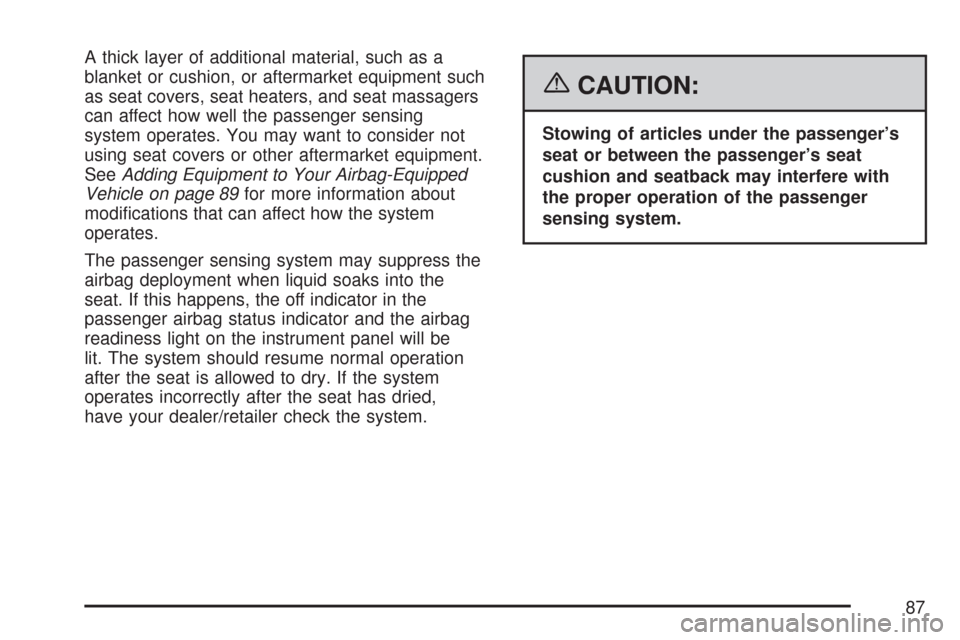
A thick layer of additional material, such as a
blanket or cushion, or aftermarket equipment such
as seat covers, seat heaters, and seat massagers
can affect how well the passenger sensing
system operates. You may want to consider not
using seat covers or other aftermarket equipment.
SeeAdding Equipment to Your Airbag-Equipped
Vehicle on page 89for more information about
modi�cations that can affect how the system
operates.
The passenger sensing system may suppress the
airbag deployment when liquid soaks into the
seat. If this happens, the off indicator in the
passenger airbag status indicator and the airbag
readiness light on the instrument panel will be
lit. The system should resume normal operation
after the seat is allowed to dry. If the system
operates incorrectly after the seat has dried,
have your dealer/retailer check the system.
{CAUTION:
Stowing of articles under the passenger’s
seat or between the passenger’s seat
cushion and seatback may interfere with
the proper operation of the passenger
sensing system.
87
Page 93 of 510
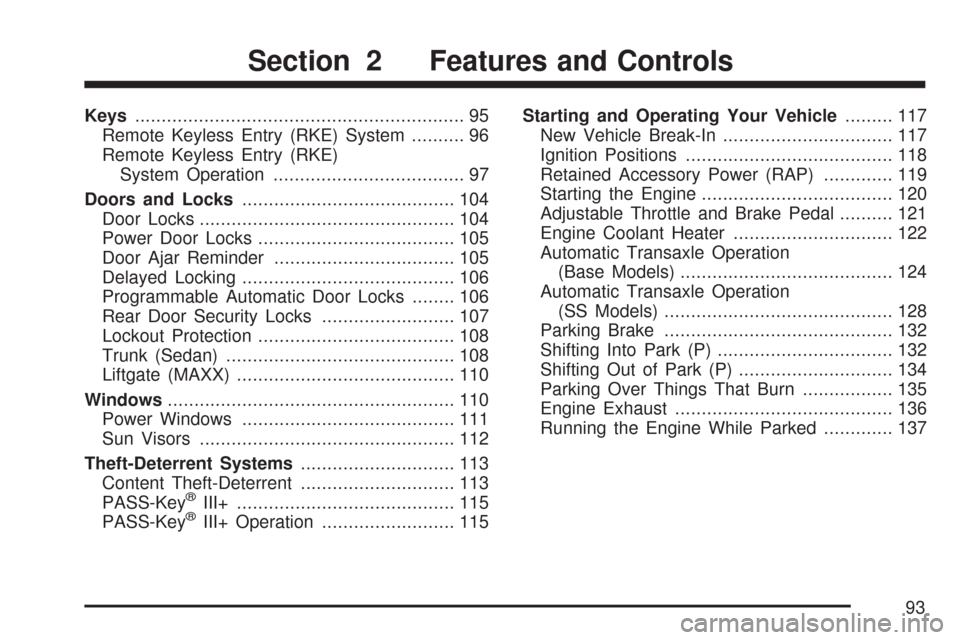
Keys.............................................................. 95
Remote Keyless Entry (RKE) System.......... 96
Remote Keyless Entry (RKE)
System Operation.................................... 97
Doors and Locks........................................ 104
Door Locks................................................ 104
Power Door Locks..................................... 105
Door Ajar Reminder.................................. 105
Delayed Locking........................................ 106
Programmable Automatic Door Locks........ 106
Rear Door Security Locks......................... 107
Lockout Protection..................................... 108
Trunk (Sedan)........................................... 108
Liftgate (MAXX)......................................... 110
Windows...................................................... 110
Power Windows........................................ 111
Sun Visors................................................ 112
Theft-Deterrent Systems............................. 113
Content Theft-Deterrent............................. 113
PASS-Key
®III+......................................... 115
PASS-Key®III+ Operation......................... 115Starting and Operating Your Vehicle......... 117
New Vehicle Break-In................................ 117
Ignition Positions....................................... 118
Retained Accessory Power (RAP)............. 119
Starting the Engine.................................... 120
Adjustable Throttle and Brake Pedal.......... 121
Engine Coolant Heater.............................. 122
Automatic Transaxle Operation
(Base Models)........................................ 124
Automatic Transaxle Operation
(SS Models)........................................... 128
Parking Brake........................................... 132
Shifting Into Park (P)................................. 132
Shifting Out of Park (P)............................. 134
Parking Over Things That Burn................. 135
Engine Exhaust......................................... 136
Running the Engine While Parked............. 137
Section 2 Features and Controls
93
Page 122 of 510

To use your adjustable throttle and brake pedal
feature, do the following:
The adjustable pedal feature is meant to be used
with the adjustable seat and adjustable steering
wheel controls to reach a safe and comfortable
position.
1. Adjust your seat to a comfortable position
where you can comfortably reach other
controls such as the radio and climate
controls.
2. Adjust the throttle and brake pedals to reach
a comfortable and safe operating position.
3. Adjust the steering wheel to a safe operating
position.Engine Coolant Heater
In very cold weather, 0°F (−18°C) or colder, the
engine coolant heater, if your vehicle has this
feature, can help. You will get easier starting
and lower fuel usage during engine warm-up.
Usually, the coolant heater should be plugged in
a minimum of four hours prior to starting your
vehicle. At temperatures above 32°F (0°C), use of
the coolant heater is not required. Your vehicle
may also have an internal thermostat in the
plug end of the cord. This will prevent operation of
the engine coolant heater when the temperature
is at or above 0°F (−18°C) as noted on the cord.
122
Page 123 of 510
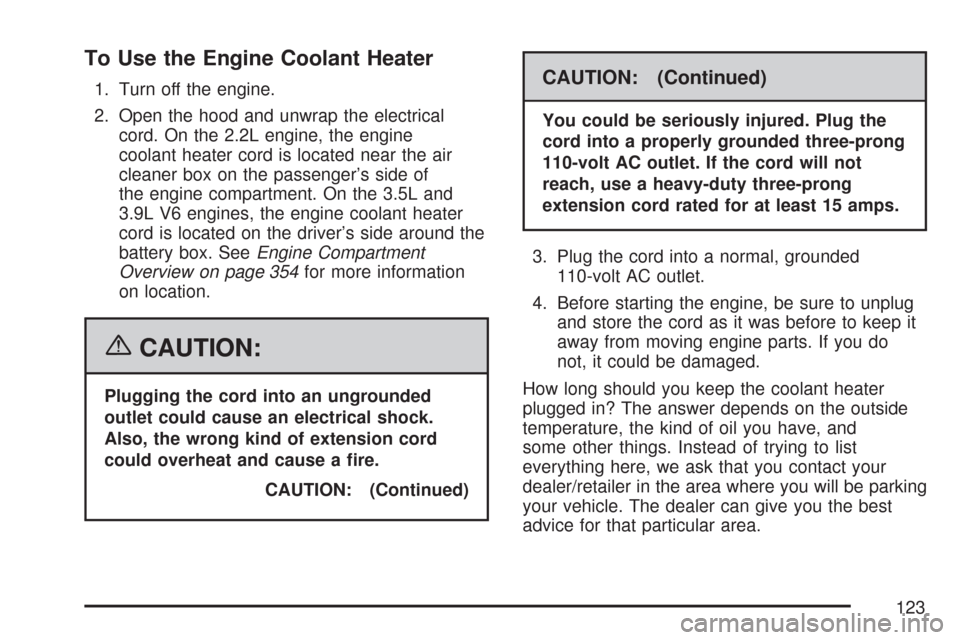
To Use the Engine Coolant Heater
1. Turn off the engine.
2. Open the hood and unwrap the electrical
cord. On the 2.2L engine, the engine
coolant heater cord is located near the air
cleaner box on the passenger’s side of
the engine compartment. On the 3.5L and
3.9L V6 engines, the engine coolant heater
cord is located on the driver’s side around the
battery box. SeeEngine Compartment
Overview on page 354for more information
on location.
{CAUTION:
Plugging the cord into an ungrounded
outlet could cause an electrical shock.
Also, the wrong kind of extension cord
could overheat and cause a �re.
CAUTION: (Continued)
CAUTION: (Continued)
You could be seriously injured. Plug the
cord into a properly grounded three-prong
110-volt AC outlet. If the cord will not
reach, use a heavy-duty three-prong
extension cord rated for at least 15 amps.
3. Plug the cord into a normal, grounded
110-volt AC outlet.
4. Before starting the engine, be sure to unplug
and store the cord as it was before to keep it
away from moving engine parts. If you do
not, it could be damaged.
How long should you keep the coolant heater
plugged in? The answer depends on the outside
temperature, the kind of oil you have, and
some other things. Instead of trying to list
everything here, we ask that you contact your
dealer/retailer in the area where you will be parking
your vehicle. The dealer can give you the best
advice for that particular area.
123
Page 189 of 510
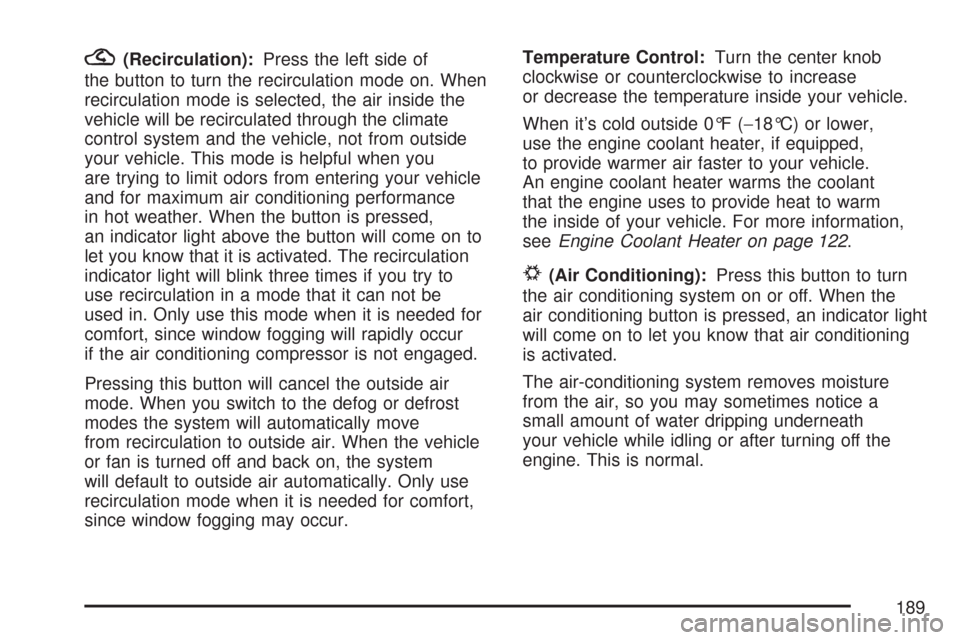
?(Recirculation):Press the left side of
the button to turn the recirculation mode on. When
recirculation mode is selected, the air inside the
vehicle will be recirculated through the climate
control system and the vehicle, not from outside
your vehicle. This mode is helpful when you
are trying to limit odors from entering your vehicle
and for maximum air conditioning performance
in hot weather. When the button is pressed,
an indicator light above the button will come on to
let you know that it is activated. The recirculation
indicator light will blink three times if you try to
use recirculation in a mode that it can not be
used in. Only use this mode when it is needed for
comfort, since window fogging will rapidly occur
if the air conditioning compressor is not engaged.
Pressing this button will cancel the outside air
mode. When you switch to the defog or defrost
modes the system will automatically move
from recirculation to outside air. When the vehicle
or fan is turned off and back on, the system
will default to outside air automatically. Only use
recirculation mode when it is needed for comfort,
since window fogging may occur.Temperature Control:Turn the center knob
clockwise or counterclockwise to increase
or decrease the temperature inside your vehicle.
When it’s cold outside 0°F (−18°C) or lower,
use the engine coolant heater, if equipped,
to provide warmer air faster to your vehicle.
An engine coolant heater warms the coolant
that the engine uses to provide heat to warm
the inside of your vehicle. For more information,
seeEngine Coolant Heater on page 122.
#(Air Conditioning):Press this button to turn
the air conditioning system on or off. When the
air conditioning button is pressed, an indicator light
will come on to let you know that air conditioning
is activated.
The air-conditioning system removes moisture
from the air, so you may sometimes notice a
small amount of water dripping underneath
your vehicle while idling or after turning off the
engine. This is normal.
189
Page 193 of 510
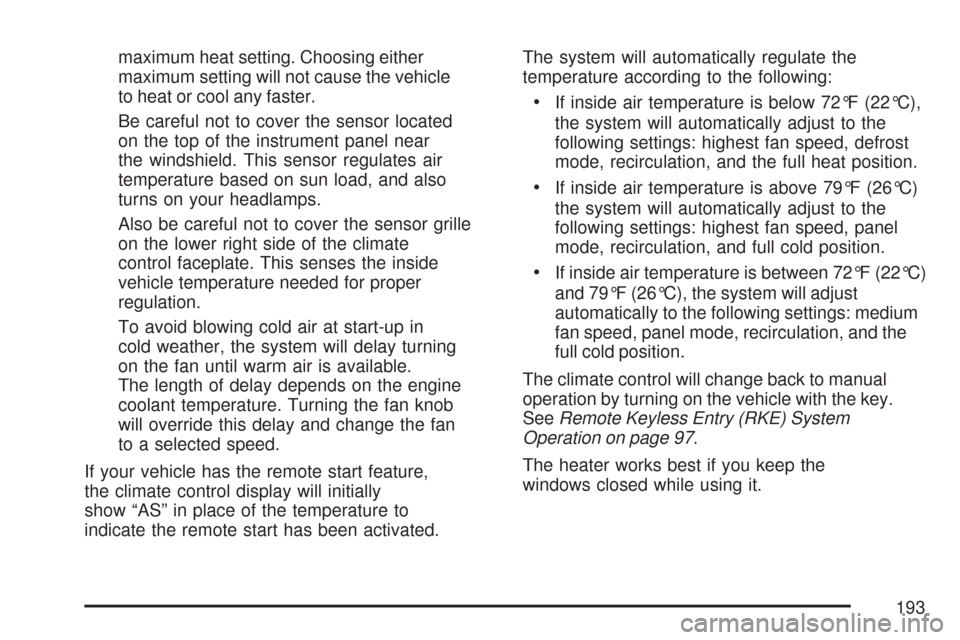
maximum heat setting. Choosing either
maximum setting will not cause the vehicle
to heat or cool any faster.
Be careful not to cover the sensor located
on the top of the instrument panel near
the windshield. This sensor regulates air
temperature based on sun load, and also
turns on your headlamps.
Also be careful not to cover the sensor grille
on the lower right side of the climate
control faceplate. This senses the inside
vehicle temperature needed for proper
regulation.
To avoid blowing cold air at start-up in
cold weather, the system will delay turning
on the fan until warm air is available.
The length of delay depends on the engine
coolant temperature. Turning the fan knob
will override this delay and change the fan
to a selected speed.
If your vehicle has the remote start feature,
the climate control display will initially
show “AS” in place of the temperature to
indicate the remote start has been activated.The system will automatically regulate the
temperature according to the following:
If inside air temperature is below 72°F (22°C),
the system will automatically adjust to the
following settings: highest fan speed, defrost
mode, recirculation, and the full heat position.
If inside air temperature is above 79°F (26°C)
the system will automatically adjust to the
following settings: highest fan speed, panel
mode, recirculation, and full cold position.
If inside air temperature is between 72°F (22°C)
and 79°F (26°C), the system will adjust
automatically to the following settings: medium
fan speed, panel mode, recirculation, and the
full cold position.
The climate control will change back to manual
operation by turning on the vehicle with the key.
SeeRemote Keyless Entry (RKE) System
Operation on page 97.
The heater works best if you keep the
windows closed while using it.
193
Page 322 of 510
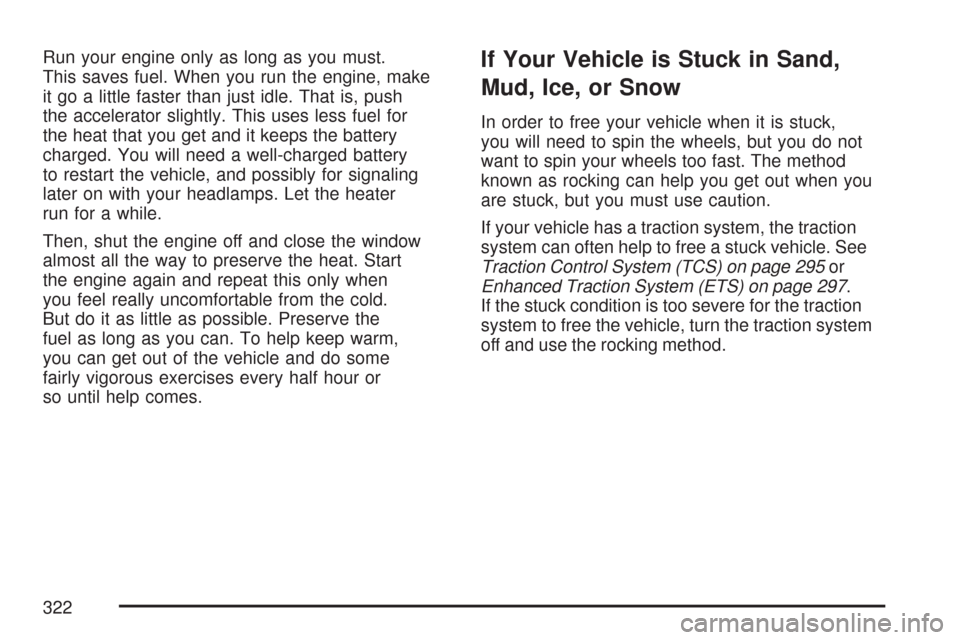
Run your engine only as long as you must.
This saves fuel. When you run the engine, make
it go a little faster than just idle. That is, push
the accelerator slightly. This uses less fuel for
the heat that you get and it keeps the battery
charged. You will need a well-charged battery
to restart the vehicle, and possibly for signaling
later on with your headlamps. Let the heater
run for a while.
Then, shut the engine off and close the window
almost all the way to preserve the heat. Start
the engine again and repeat this only when
you feel really uncomfortable from the cold.
But do it as little as possible. Preserve the
fuel as long as you can. To help keep warm,
you can get out of the vehicle and do some
fairly vigorous exercises every half hour or
so until help comes.If Your Vehicle is Stuck in Sand,
Mud, Ice, or Snow
In order to free your vehicle when it is stuck,
you will need to spin the wheels, but you do not
want to spin your wheels too fast. The method
known as rocking can help you get out when you
are stuck, but you must use caution.
If your vehicle has a traction system, the traction
system can often help to free a stuck vehicle. See
Traction Control System (TCS) on page 295or
Enhanced Traction System (ETS) on page 297.
If the stuck condition is too severe for the traction
system to free the vehicle, turn the traction system
off and use the rocking method.
322
Page 369 of 510
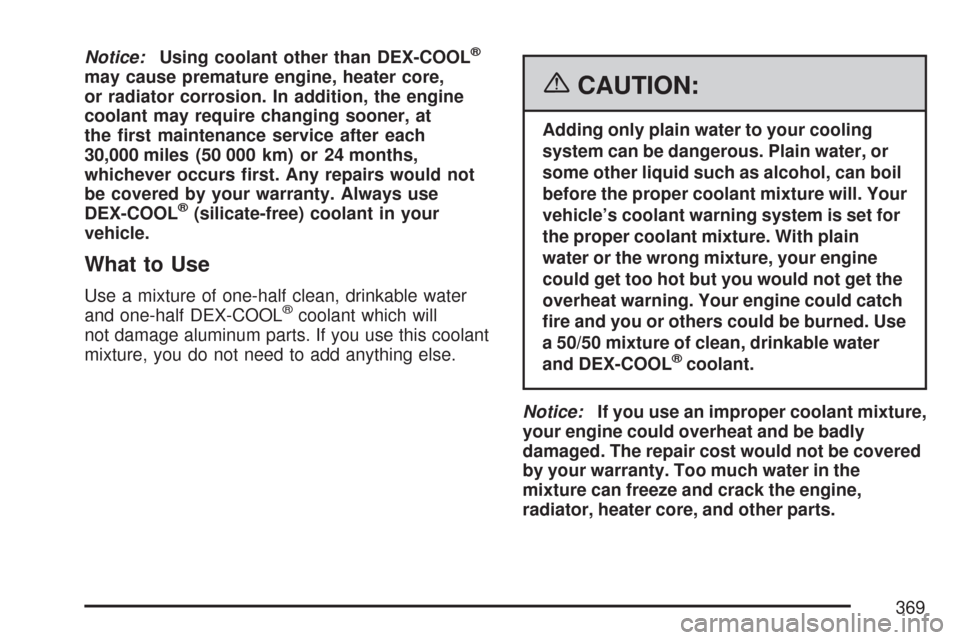
Notice:Using coolant other than DEX-COOL®
may cause premature engine, heater core,
or radiator corrosion. In addition, the engine
coolant may require changing sooner, at
the �rst maintenance service after each
30,000 miles (50 000 km) or 24 months,
whichever occurs �rst. Any repairs would not
be covered by your warranty. Always use
DEX-COOL
®(silicate-free) coolant in your
vehicle.
What to Use
Use a mixture of one-half clean, drinkable water
and one-half DEX-COOL®coolant which will
not damage aluminum parts. If you use this coolant
mixture, you do not need to add anything else.
{CAUTION:
Adding only plain water to your cooling
system can be dangerous. Plain water, or
some other liquid such as alcohol, can boil
before the proper coolant mixture will. Your
vehicle’s coolant warning system is set for
the proper coolant mixture. With plain
water or the wrong mixture, your engine
could get too hot but you would not get the
overheat warning. Your engine could catch
�re and you or others could be burned. Use
a 50/50 mixture of clean, drinkable water
and DEX-COOL
®coolant.
Notice:If you use an improper coolant mixture,
your engine could overheat and be badly
damaged. The repair cost would not be covered
by your warranty. Too much water in the
mixture can freeze and crack the engine,
radiator, heater core, and other parts.
369